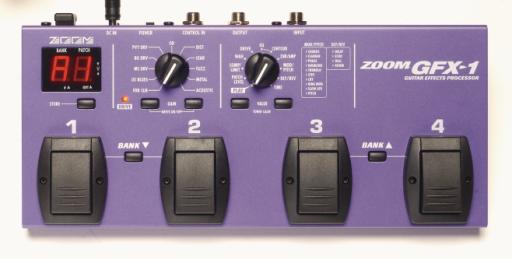MusicRadar Verdict
Ideal for those domestic one-on-one practice sessions.
Pros
- +
The solid construction, the price and the cool look and ease of use.
Cons
- -
Tonally, it doesn't really stand out from the crowd.
MusicRadar's got your back

A gig-ready multi-FX for under 100 quid?

It's all kept simple around the back.
Zoom has long been at the forefront of the production of affordable yet tonally valid multi-FX and recording units but, no matter how impressive models such as the 505II and 606 undoubtedly are, we'd question whether any player would want to use one live.
The flagship GFX-8 console aside, Zoom's guitar-related products are mostly small and, not to put too fine a point on it, rather plastic in construction.
Which, considering the sheer quality of a majority of the on-board tones of these units, is rather a shame: they'd arguably last half a set beneath the big old boots of many of today's contemporary players.
Enter the GFX-1, a new gladiator into the packed multi-FX arena. It is slim and compact, hewn from the sturdiest steel, and fully loaded with many of the features that have made Zoom so popular over the last decade or so.
Overview
There are nine choices of chorus, each with a slightly increased rate and depth, rather than a single option coupled with rate and depth parameters.
It's a similar tale with the 11 amp and drive options, although you can alter the gain, EQ and contour of each. The unit also allows you to alter the time of the delay and reverb settings, with their specific number - delays one to nine - being related to the incremental increase in feedback.
It's all self-explanatory, with a pair of effect selectors working in tandem with the display and specific duos of ± keys, but make sure that you store the setting before rotating the second knob back to Play mode - otherwise it'll forget your tone tailoring without warning!
With four footswitches, the unit offers 40 fully programmable patches split into 10 banks of four, selected in the usual way.
There are no operation lights for the pedals, so special attention must be paid to the LED so that you know where you are, and getting to grips with the abbreviations Zoom has used for the unit's features is time well spent.
Sounds
We have few complaints about the effects side here, but we did find the middle ground of the overdrive and amp offerings to be less impressive.
No matter how much we played with the EQ and contour areas, or how much delay we lathered on, only the very clean or nu-metal tones seemed to benefit from the digitally coloured high end.
Although not really in the same class as the more expensive Zoom GFX-3 due to its unavoidably limited editing interface, as a desktop effect unit for practice or writing this is a pretty cool tool.
We can certainly imagine its use on-stage thanks to its construction, but it may be just that bit too small and unlit for professional use.
Simon Bradley is a guitar and especially rock guitar expert who worked for Guitarist magazine and has in the past contributed to world-leading music and guitar titles like MusicRadar (obviously), Guitarist, Guitar World and Louder. What he doesn't know about Brian May's playing and, especially, the Red Special, isn't worth knowing.

“Almost a lifetime ago, a few Burnage lads got together and created something special. Something that time can’t out date”: Original Oasis drummer Tony McCarroll pens a wistful message out to his old bandmates

“A high-quality solution for capturing your drums”: Sennheiser MD 421 Kompakt review

“I need to build a sound of my own that has the power that I want”: Floating Points hates festival sound systems so much that he’s invented his own









